Bloodborne's combat convinced me I don't need a sword and shield any more
Impressions from the first hour of From Software's PS4 exclusive.
Old habits are hard to break, especially when they're ones that kept you safe through trying times. When you walked through the Valley in the shadow of Drakes, when you descended into the toxic depths of Blighttown, and when you paced the gleaming ramparts of Anor Londo, the old sword and shield combo was a reliable fallback in Dark Souls. Block, slash, back off, wait. It was a mantra you repeated to yourself over and over, a song whose comforting words saw you through the darkest nights. Block, slash, back off, wait. Dark Souls' creator Hidetaka Miyazaki doesn't want you to get comfortable, which is why his latest title, PS4 exclusive Bloodborne, is taking that fallback away. And as suspected, learning to get by in a From Software game without relying on a sword and shield doesn't come easy - at least at first.
Starting the game, you awaken, laid out on a gurney, in Iosefka's Clinic, a grimy, sunless room lined with dirty bottles and rusted medical equipment. A man in a wheelchair with his eyes bandaged, presumably Iosefka himself, looms over you. He calls you a 'Paleblood,' tells you you'll need some Yharnam blood in you, and that you'll need a contract in order to begin the transfusion. This opens up the Character Creation screen, where you'll choose the appearance and gender of your avatar. You also select your character's personal history, or 'origin', which affects their starting attributes. Being a Lone Survivor gives you higher life essence and vigour, for example; other choices include Milquetoast (all stats are average), a Noble Scion, a Troubled Childhood and a Waste of Skin - a miserable state as you're told you're worthless, talentless, and shouldn't even really be alive. How charming, and oh so very Souls-like.
Upon creating your character and 'signing' the contract, the transfusion will begin, Iosefka will disappear, a werewolf will rise from a puddle of blood on the floor and reach out to you before bursting into flames, and then hissing little imp-like creatures will crawl up over the gurney and you'll pass out, awakening some time later. After getting up you're free to explore the clinic, though the only company will be your own creaking footsteps, until you stumble upon a werewolf that will immediately kill you. You'll reawaken (again) in the Hunter's Dream, a quiet, moonlit churchyard that'll act as your hub world. It's here you'll be able to level up, upgrade weapons, and, by inspecting various tombstones, warp to other locations. Upon the steps of the church, a life-sized doll stares at you with blank, glassy eyes - its use unapparent for now. Approaching it, the text description reads simply that it's "Just a plain doll." Not likely.

As you ascend the church steps, those imp-like creatures - loyal servants of Hunters like yourself called Messengers - rise out of the ground holding trick weapons, offering you a choice between a Saw Cleaver, a Hunter's Axe, and a Threaded Cane. I take the Cleaver. Another set of Messengers offer firearms, a choice between a Hunter's Pistol and a Hunter's Blunderbuss. I take the Pistol. You can equip up to two weapons per hand to switch between, though seemingly weapons will be nowhere near as plentiful as in Dark Souls 1 and 2 - they never drop from fallen foes in Bloodborne, for example. The Messengers hand me a third gift, a notebook, which the text states will allow them to leave my messages with hunters in other worlds. A soapstone, in other words. The church doors are locked for now, but approaching another Messenger sat in a birdbath and rubbing its hands greedily, I'm told it's here I can trade in Blood Echoes, which take the place of Souls as currency here, to buy and sell items. There are only basic items available to buy at the moment; Blood Vials, which take the place of Estus Flasks; Pebbles, which are used to distract enemies; Quicksilver bullets, and firebombs.
Inspecting a nearby Tombstone of Awakening warps me back to Iosefka's Clinic, though now I'm armed I'll have a better chance of passing through. The werewolf that dispatched me is still there, only now his eyes shine white. This trait means he holds the Blood Echoes I dropped upon death - or would have dropped, had he not been the first enemy I encountered. As with the Souls games, you'll drop your primary resource upon death at the spot in which you died, but in Bloodborne, a nearby enemy will sometimes snatch up your Blood Echoes before you manage to return to the spot to retrieve them. In that instance, you'll have to kill that enemy in order to restore the Blood Echoes you had previously collected, rather than simply touching a telltale pool of blood on the ground.
A few slashes with the Saw Cleaver quickly brings down the beast. The Cleaver has two states that you can switch between with L1; closed over, it'll deal greater damage at short range, but once snapped open it'll be much more useful at fending back greater numbers of enemies with wide, sweeping slashes. You don't have to steadfastly stick with one form or the other during combat, however - changing forms during attacks will change up the combos your character performs. Opening with a sweeping attack and quickly changing to a close quarters slice will help to open up enemies using shields, for instance.
Stumbling out of the clinic, up some carved steps and opening up a heaving, creaking set of iron gates, I suddenly find myself in central Yharnam - its 19th century gothic-inspired streets paved with wrecked carriages, decomposing horses, and rows upon rows of padlocked coffins. It's an incredible sight. Boletaria, Lordran and Drangleic were faded, ancient worlds; crumbling, medieval and melancholy. The twisted streets of Yharnam are something else altogether - dark, diseased, and exceedingly hostile. Gleaming spires, ornate fortresses and once-proud marble throne rooms are replaced by wrought iron spikes, weathered limestone statues and dirty alleyways. Sometimes you'll spy a sliver of light creeping under a door or out of a shuttered window and see a flicker of life inside, hear the murmur of voices within, lamenting the fate of the city but never allowing you to cross the threshold. As a whole Yharnam is a haunting creation, but it depicts a darker, more violent kind of beauty, the sort that'll have you standing and staring as the yellow flames of a bonfire gently lick a mutilated werewolf carcass.
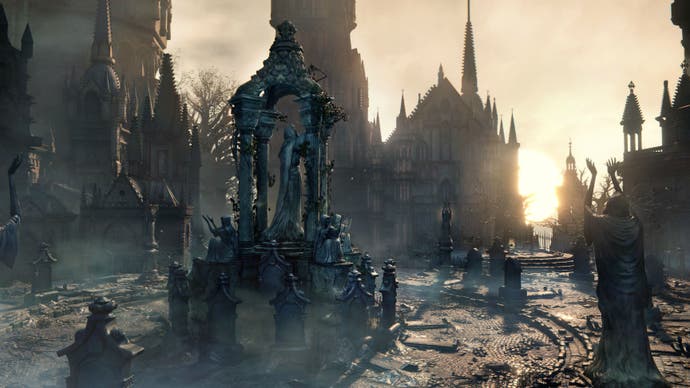
Approaching one such bonfire from afar, I see a large group of standard enemies gathered - citizens of Yharnam that have become infected with a so-called plague of beasts, becoming maddened as a result. Somewhere, a bell tolls, signalling to the congregated mob that it's time to resume actively hunting for beasts. I watch them from afar for a time - some stand still, others wander up and down in groups, and still more seemed a touch unpredictable as they didn't appear to have a set patrol path. Whereas before in Dark Souls I'd have attempted to kite enemies, pulling them in one by one to make them more manageable, here that endeavour becomes more difficult. If I'm lucky I can use a pebble to distract one, but more often than not you'll grab the attention of two or three at a time.
It's at this point that the difference in combat between Bloodborne and From Software's previous titles really becomes apparent. You move much faster, for starters, the dodge button enabling you to weave quickly, though sometimes clumsily, in and out and around several enemies at once. With a sword and shield combo in Souls, the instinct was to remain unmoved, allowing combatants to come to you while keeping your defences up and waiting patiently for the right time to attack. In Bloodborne, enemies come so thick and fast that this approach would be suicide, even before factoring in your lack of defensive equipment. Your foes are faster and smarter, too, and have a wide array of attacks. Some prod you with a pitchfork while their comrades call you an accursed beast and wave fire in your face to scare you off. Some drag their scythes along on the ground behind them as they patrol, filling the air with a horrible scraping sound as they screech across the cobblestones.
Perhaps the most important new aspect of combat, however, is the firearm, which takes the place of a shield in your left hand. Used as a long-range weapon it's fairly useless, at least at this very early stage of the game, but as soon as you figure out what it really is - a device with which to parry incoming attacks - it's a revelation. Firing the gun with L2 just as an enemy is about to land a blow staggers them, throwing them off balance and allowing you to follow up with a swift and bloody counterattack that will instantly kill lower-level aggressors, drenching your cloak in their blood in the process. This mechanic all but forces you to be more pro-active, and thus completely changes the pace of Bloodborne's combat. Where before, in Dark Souls, I'd be slowly circling singular enemies, suffering their attacks while feeling for the right moment to plunge a blade into their back, now I'm chasing them down and facing mobs of them head on, goading them into battle. Charged attacks can also be carried out on enemies by holding and releasing R2, and in the case of one that is unaware of your presence, can stun them long enough to carry out a brutal follow-up with R1.
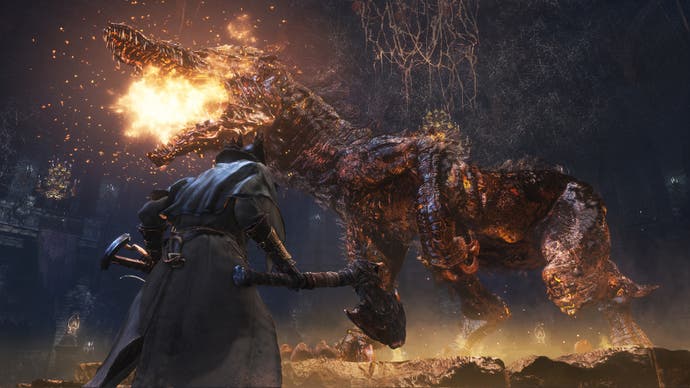
In addition to this, the Regain system also rewards aggressive play by allowing you to claw back health lost from enemy attacks if you retaliate within a certain timeframe. After being dealt damage, you'll notice an orange section momentarily appears on your red health bar. This is how much health you can potentially get back from counterattacking, and each consecutive hit will add a small portion of that orange bar back to your overall health. It doesn't make you invincible, but it does embolden you to strike fast and keep consecutive skirmishes going for longer than you might otherwise have done. Make no mistake, combat here still demands strategic thinking and some degree of foresight, but it feels much more immediate.
My hour-long demo ends with the first boss fight of the game - the Cleric Beast, a tangled, towering mass of bones and branches and lichen that leaps over a wall with a bloodcurdling screech and launches directly at me. One of my favourite aspects of Dark Souls was its incredibly detailed monster design, so it's good to see that still intact here. The Cleric Beast appears relentless in its attacks, but knocking back its arm with the firearm does seem to leave it vulnerable to a more powerful follow-up with the Cleaver.
On one hand, Bloodborne is unmistakably Souls in nature. From the mournful music to the surprise enemy placements, to the labyrinthine, complex world and the need to strategise and learn from your mistakes in order to inch forwards, this is an experience that Souls fans will immediately recognise. But there are fundamental differences in its design that make playing Bloodborne a markedly different experience. Though an hour wasn't totally enough to wean me off all the habits I learned while playing From Software's previous games, I am no longer a shieldmaiden of Lordran. Prior to playing, I had thought I'd just stick to my Souls' 'block, slash, back off, wait' mantra whenever and however I could. Playing through just an hour of Bloodborne, I can see that simply won't be the case, and nor do I want it to be. I'm a convert; in Yharnam, a good offence is the best defence, and that's the song I'll be singing come release day.
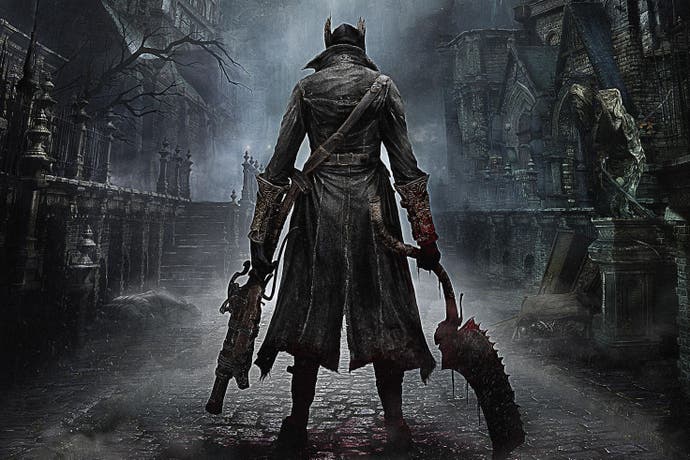


.png?width=291&height=164&fit=crop&quality=80&format=jpg&auto=webp)

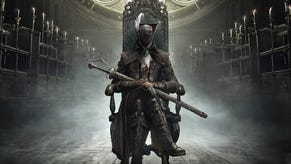

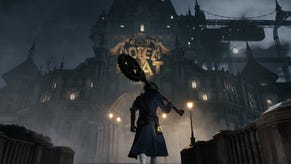




.png?width=291&height=164&fit=crop&quality=80&format=jpg&auto=webp)



